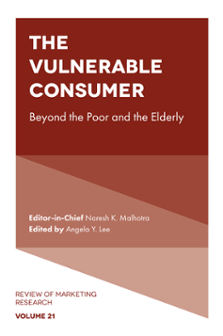
Index
ISBN: 978-1-80262-956-9, eISBN: 978-1-80262-955-2
ISSN: 1548-6435
Publication date: 24 June 2024
Citation
(2024), "Index", Lee, A.Y. (Ed.) The Vulnerable Consumer (Review of Marketing Research, Vol. 21), Emerald Publishing Limited, Leeds, pp. 167-171. https://doi.org/10.1108/S1548-643520240000021011
Publisher
:Emerald Publishing Limited
Copyright © 2024 Angela Y. Lee. Published under exclusive licence by Emerald Publishing Limited
INDEX
- Prelims
- The Vulnerable Consumer: Beyond the Poor and the Elderly
- Aging and Vulnerabilities in Consumer Information Processing
- Vulnerability and Consumer Poverty: An Explication of Consumption Adequacy
- Not Knowing Who I Am: Implications for Materialism and Consumption Behaviors
- From Stigma to Scarcity: On Interpersonal and Cognitive Sources of Vulnerability for Consumers in Poverty
- The Yin and Yang of Hard Times: When Can States of Vulnerability Motivate Self-Improvement?
- Marketplace Solutions to Motivational Threats: Helping Consumers With Four Distinct Types of Vulnerability*
- Leaves in the Wind: Underdeveloped Thinking Systems Increase Vulnerability to Judgments Driven by Salient Stimuli
- “I Did Not Think of Myself as a ‘Customer’”: The Confluence of Intertwined Vulnerabilities Among Subsistence Consumers Through Marketplace Literacy
- A Consumer Vulnerability Perspective on Eviction
- Index